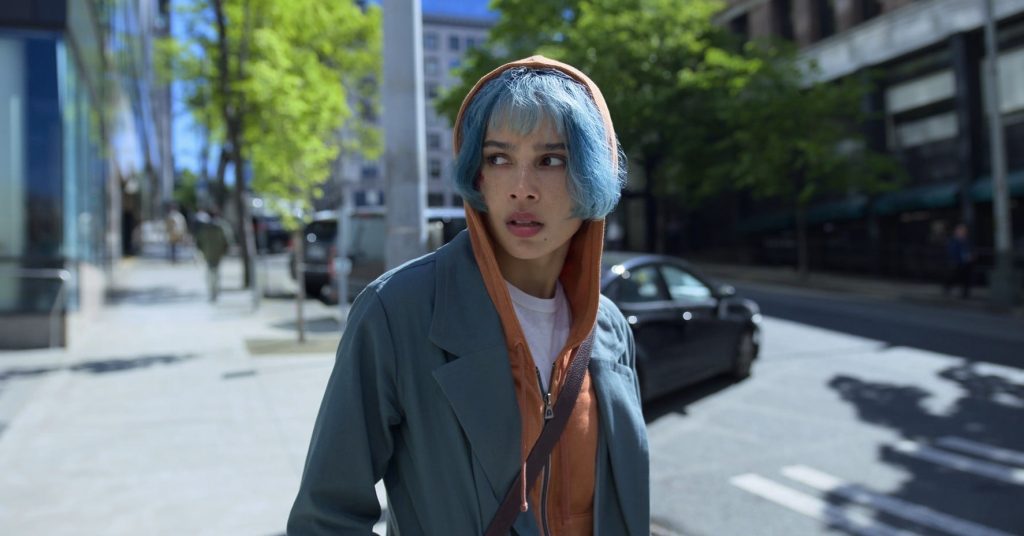Nearly forty years into his directorial career, Steven Soderbergh refuses to settle. Coming off Magic Mike’s (2012) massive success, he spent most of the ensuing years on television with The Knick (2014-2015) and Mosaic (2017-2018). Then came the iPhone double-feature of Unsane (2018) and High Flying Bird (2019), the latter leading into his Netflix residency. His recent move to a creative home HBO Max has led to superb Let Them All Talk (2020) and No Sudden Move (2021). Coming out of the gates hot in 2022 Soderbergh continues to outdo himself, this time with KIMI, a paranoid thriller doused in Hitchock and Pakula yet somehow singularly Soderberghian.
Synopsis

KIMI fixates on Angela Childs (Zoë Kravitz), a work-from-home programmer crippled by agoraphobia. She corrects bugs from Alexa-stand-in KIMI, a product nearing a major market launch. When customers have an issue with KIMI, the audio makes its way to Angela or someone like her. They tweak the code so no one will have the same issue again. It’s while working on one of these problem recordings that Angela hears something. She lingers on the audio until she thinks she’s sorted out. Underneath loud music, she hears what sounds like a woman being violently assaulted. Facing disbelief at every turn, Angela has to overcome both her aversion to the world and those who want to bury what she found in order to uncover a twisty conspiracy.
Story

Legendary scribe David Koepp penned KIMI. As the writer responsible for Jurassic Park (1993), Carlito’s Way (1993), and Panic Room (2002), to name a few, Koepp knows his way around the thrills and chills of accomplished screenwriting. His work here is crisp, almost brutal, in its fixedness. Whatever the early drafts looked like, Koepp has excised anything not strictly necessary for the story. Therefore, his script offers up a breathtaking pace. The first act methodically introduces Angela, and just enough of the corporate structure around her to know something hideous waits in the wings. The best thriller screenplays understand that momentum manipulates audience nerves rather unlike anything else. Once the story fuse is lit, KIMI barrels ahead through an increasingly desperate series of dangers.
Soderbergh and Sound
Picking that tone up, Soderbergh directs the hell out of this story. From the first scenes in Angela’s apartment, he strives to reflect her personal discombobulation in a mise-en-scène that destabilizes the viewer. Favoring stark overhead shots, an array of high and low angles, and a steadily roaming camera, Soderbergh mines every bit of aesthetic possibility from the contained space. Yet, he also recognizes when to just let the camera sit there and unnerve us by refusing to budge. When Angela repeatedly listens to the audio, we must just hold our breath as she tips further into the darkness. Once we do leave the apartment, Soderbergh just shows off. He propels us into Angela’s world with a master’s deployment of a sonic landscape. Paired with an anxiety-inducing utilization of a frantic frame rate, key turns and footsteps land like thunder.
It is that latter point that also touches on an exceptional component: KIMI’s sound design. Of course, the film hinges on an audio recording, so there is a narrative focus on sound from the start. However, that is only a corner of what goes on. In addition to the aforementioned amplified sound meant to reflect Angela’s heightened stress, Soderbergh vacillates between sound and silence. Before leaving the apartment, Angela repeatedly puts on and takes off her noise-canceling headphones, slipping us back and forth from normal room noise to deadened silence. Furthermore, Cliff Martinez’s score and the production’s song choices combine to deliver a sonic collective that takes full advantage of the medium’s potential. Too often thrillers resort to heavy-handed sound cues and needle drops to manipulate emotion. KIMI embodies the cinematic antidote, a film that guides the viewer towards mood and theme with sound.
Zoë Kravitz

Of course, at the center of nearly every frame in KIMI is Zoë Kravitz. The woman who will shortly arrive on screens as Catwoman delivers a nerve-shredding and committed performance that is equal parts captivating and exhausting. Kravitz expresses Angela’s profound anxiety in large part through physicality. Her motions are precise and measured, defined by repetition. Even when she’s alone in her apartment, she walks aggressively. Often with her head tilted down as if she is fending off the very air around her. From that baseline, as escalating threats from corporate structures work to silence her, Kravitz ratchets up the intensity. By the final act, her performance is the acting equivalent of a raw, pulsating, nerve, and it is the dream coupling with the aesthetic realm Soderbergh builds around her. Kravitz nearly single-handedly carries the film from an acting perspective, and she does not land a single false beat.
I invoked Alfred Hitchock and Alan J. Pakula at the top of this review because KIMI is clearly positioned in the lineage of their respective filmographies. Here, Hitchcock’s penchant for tales of innocent figures on the run blends with Pakula’s fixation on an organized conspiracy, but while other filmmakers would fall into copying those masters, Soderbergh only nods to them as a launch point. Yes, comparisons to Rear Window (1954) and The Parallax View (1974) have their merits, but KIMI’s execution is singular in how Soderbergh and company fire on all creative cylinders. KIMI bursts with aesthetic inventiveness, narrative dynamism, and a wholly committed lead actress. All of this is to say, reducing this film to its reference points is a massive oversight. KIMI sets the high bar for thrills in 2022.
Before we let you go, we have officially launched our merch store! Check out all of our amazing apparel when you click here and type in GVN15 at checkout for a 15% discount!
Make sure to check out our podcasts each week including Geek Vibes Live, Top 10 with Tia, Wrestling Geeks Alliance and more! For major deals and money off on Amazon, make sure to use our affiliate link!

Devin McGrath-Conwell holds a B.A. in Film / English from Middlebury College and is currently pursuing an MFA in Screenwriting from Emerson College. His obsessions include all things horror, David Lynch, the darkest of satires, and Billy Joel. Devin’s writing has also appeared in publications such as Filmhounds Magazine, Film Cred, Horror Homeroom, and Cinema Scholars.







